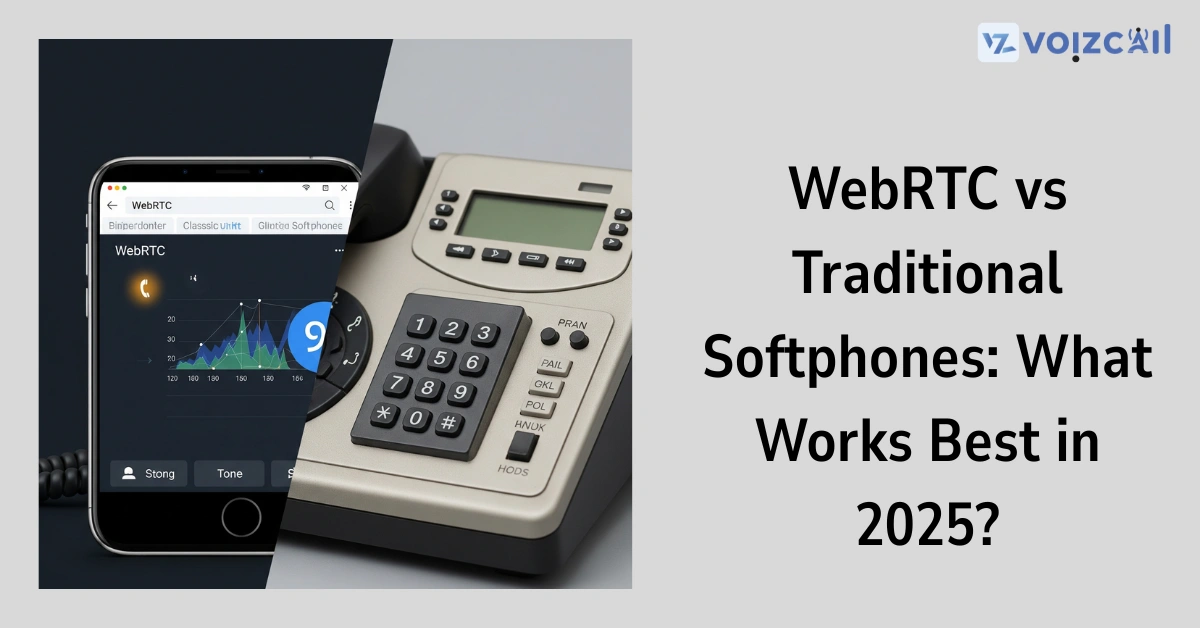


21/Jul/2025
Nowadays communication is changing at a rate like never before in 2025. When it comes to working with an offshore team, covering customers all over the world, or setting up a call center entirely,
One giant question repeats itself over and over:
And on which WebRTC-based phone system should you use it or prefer the traditional softphones?
Both technologies assist you in making phone calls via the internet however; their performance attributes, configuration and flexibility differ tremendously.
This will go into the depths of the WebRTC vs traditional softphones discussion, so you can make an informed choice on what suits your business communication in 2025 better.
What is a Softphone?
A soft phone, also written as softphone, is software, which allows telephone calls to be made using a computer, tablet or smartphone-using an ordinary internet connection, not a regular phone line.
Most often it is compatible with SIP (Session Initiation Protocol) and it has to be installed and configured (the same with Zoiper, Bria, or Linphone).
Key Features:
VoIP over SIP calling
Requires installation of software
Typically compatible with PBX or VoIP server
The ability to support videos, voicemail and chat (depending on the platform)
What is WebRTC ( Web Real-Time Communication)?
WebRTC is an open-source initiative by Google that enables real-time voice, video and data delivery that bypasses a plugin, and app, and simply works through the web browser.
Call / Email for Sales Inquiry Today
It is what drives most of the popular communication applications (such as Google Meet and Discord), and it is currently transforming the VoIP phone systems as well.
Key Benefits:
Require no installation, running on browsers
Lower latency and Call connection speed
Native in Chrome, Firefox, edge and Safari
Incorruptible by design e.g. end-to-end encryption (DTLS, SRTP)
Perfect to integrate into Web apps and CRMs
Top Differences Between WebRTC and Traditional Softphones
Attribute Olden SFT WebRTC
Installation Necessary Not required (but it has to be a browser-based one)
Device Flexibility Only those devices that support the app Any device with browser
Set up Time Complex (SIP settings, codecs) Simple (URL-based calling)
What are the differences between WebRTC and Traditional Softphones?
Function Softphones WebRTC
Installation Abs. needed Not at all (browser-based)
Flexibility of Devices Phrased on having app Any device having browser
Time to set up Complex (SIP settings, codecs) Simple (URL-based calling)
Security Configuration dependent In-built encryption
Best Use Case Call centers, desk based agents Remote teams, web apps, mobile first teams
What are the Times To Use a Traditional Softphone?
Traditional softphones continue to shine in such situations as:
VoIP headsets with desk calls agents in the call centers
Companies which are already using SIP trunk and PBX systems
Who require heavy call control, multi line dashboards or using plugins
They are tested, trialled and highly customizable. However, they need IT expertise, manual setting up, and in many cases longer setup time.
The reasons why WebRTC is the most favorite choice in 2025
Easy, Uncomplicated, and Web-Constructed
WebRTC is replacing this due to its advantage of:
It is native to browsers and it does not need installations
Best suitable where employees work through their devices and BYOD (bring your own device) culture is in use
Does not break on mobile browsers
Easy plugging to web-based CRMs, SaaS tools and customer portals
Example:
Would you like to insert calling in your web dashboard? WebRTC enables its users to click and call within your application without installations.
Real Business original WebRTC and Softphones
Use Case Top Choice
Customer service through web page WebRTC
CRM WebRTC sale teams
Big call centers Plain Softphones
Personal devices with remote agents WebRTC
Enterprises legacy VoIP Traditional Softphones
New SaaS applications or startups WebRTC
Business are switching to WebRTC soft phones 2025 Trend: (Business) Switching to WebRTC Softphones
As market trend indicates:
In 2025, more than 65 per cent of VoIP roll-outs involve WebRTC integration
The reason is that WebRTC is being adopted due to its lightweight deployment, its suitability with mobile environments, and the lack of training needed to use it
Firms implementing WebRTC claim to experience reduced support tickets, ushering and improved caliber of calls
Conclusions: Alright, so Which Do You Take?
Your preference between WebRTC and traditional softphones will rely upon your:
Team configuration (remote or office based)
Technical capability
Integration needs
Security requirements
Long-term scalability
However, WebRTC is well on course to being the first choice of businesses interested in:
Stress-free calling using any device
Facile interaction with cloud instruments
Pace, protection and easy usage
Softphones as we know them are not dead yet, but WebRTC is getting ready to define future of business communications.